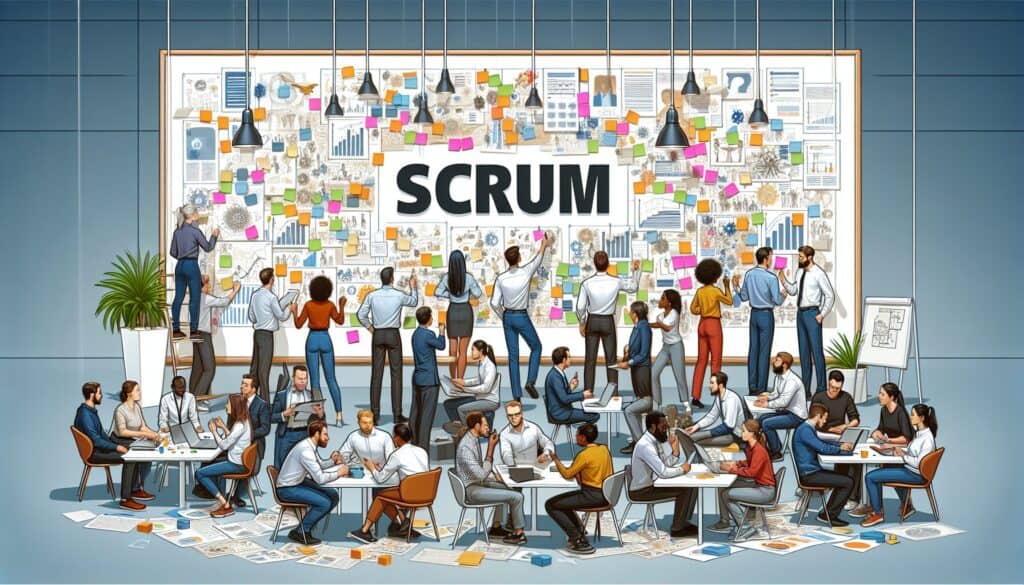An agile estructura for developing, delivering, and sustaining complex products, with an emphasis on iterative development, collaboration, and empirical control de procesos.
- Metodologías: Ingeniería, Calidad
Melé

Melé
- Metodología ágil, Desarrollo ágil de productos, Mejora continua, Desarrollo iterativo, Lista de productos pendientes, Gestión de proyectos, Melé, Planificación de sprints, Trabajo en equipo
Objetivo:
Cómo se utiliza:
- Work is done in short, time-boxed iterations called Sprints. A Product Owner manages a prioritized Product Backlog. A Melé Master facilitates the process for the Development Team. Regular events include Sprint Planning, Daily Scrums, Sprint Review, and Sprint Retrospective.
Ventajas
- Adaptable to changing requirements; Promotes collaboration and communication within the team and with stakeholders; Delivers working software frequently; Encourages continuous improvement and team empowerment.
Contras
- Requires a significant cultural shift and commitment from the team and organization; Can be challenging to implement correctly (ScrumBut); Effectiveness heavily depends on team dynamics and the Scrum Master's skill; May not be suitable for all types of projects.
Categorías:
- Ideación, Diseño de producto, Gestión de proyectos
Ideal para:
- Managing complex product development, especially in software, where requirements are evolving or unclear, and iterative delivery is beneficial.
Scrum can be effectively utilized in various industries beyond software development, including manufacturing, healthcare, and product design, where teams face unpredictable challenges and seek to improve the quality of outputs through iterative cycles. In product design, for example, cross-functional teams consisting of designers, engineers, and marketers can use Scrum to create prototypes, adapt their designs based on user feedback, and ensure that the final product aligns closely with market needs. Industries such as automotive and aerospace have adopted Scrum principles to foster collaboration among diverse teams that must harmonize engineering, design, and user experience. Scrum thrives in project contexts that require rapid adaptation and ongoing stakeholder engagement, such as during the early stages of product lifecycle development, where customer needs and market conditions may shift quickly. Scrum encourages participation from various stakeholders—such as customers, end-users, and business analysts—enabling a comprehensive collection of requirements that improves product offerings. Sprints serve as effective checkpoints for assessing progress and realigning goals, while events like Sprint Reviews provide a platform for showcasing work to stakeholders and gathering constructive feedback, promoting a culture of continuous improvement. Large organizations utilizing Scrum can see enhanced efficiency and faster delivery timelines, as smaller teams within different departments coordinate their efforts while staying aligned with strategic objectives. The iterative nature of Scrum supports the practice of testing ideas early and often, which is particularly beneficial in a fast-paced market where innovation is a necessity.
Pasos clave de esta metodología
- Conduct Sprint Planning to define the Sprint Goal and select items from the Product Backlog.
- Hold Daily Scrums for the Development Team to synchronize activities and plan work for the next 24 hours.
- Develop the product increment throughout the Sprint, ensuring adherence to quality standards.
- Facilitate the Sprint Review to demonstrate the completed increment and gather feedback from stakeholders.
- Conduct a Sprint Retrospective to reflect on the Sprint process and identify improvements for future Sprints.
Consejos profesionales
- Utilize metrics like velocity and burn-down charts to drive Sprint planning and evaluate team capacity for future Sprints.
- Encourage regular feedback from stakeholders by involving them in Sprint Reviews to ensure alignment with user needs and product goals.
- Implement a structured approach to Sprint Retrospectives by using techniques like "Start-Stop-Continue" to facilitate meaningful discussions and actionable improvement points.
Leer y comparar varias metodologías, recomendamos el
> Amplio repositorio de metodologías <
junto con otras más de 400 metodologías.
Sus comentarios sobre esta metodología o información adicional son bienvenidos en la dirección sección de comentarios ↓ , así como cualquier idea o enlace relacionado con la ingeniería.
Contexto histórico
1960
1980
1983
1990
1995
2000
2010
1950
1980
1980
1986
1994
1995
2000
(si se desconoce la fecha o no es relevante, por ejemplo "mecánica de fluidos", se ofrece una estimación redondeada de su notable aparición)














Publicaciones relacionadas
Simulación de Monte Carlo
Pruebas basadas en modelos
Comprobación de modelos
Investigación con métodos mixtos
A prueba de errores (Poka-Yoke)
Pruebas del perfil de la misión